Winger22
Member
I use a carabiner and clip the handle on the lid to one of the handles on the 3-in-1 when I'm not using it.

I don't mean to discredit your experience friend, but I tested this yesterday on my brew and I'm within 1 degree C from ETC and anywhere in the grain bed. It could be that I made a Berliner (1.037) and therefore didn't have a big enough grain bed to cause inconsistencies. I will check again next brew and see. But my initial conjecture may still hold up that you have a channeling issue going on.
I will send along images of how we use the medium system and maybe that might give you some ideas on how to adapt. It took us a long time to learn how to use the equipment the best way.
May I ask: Are you using the analog power controller or the digital one? I bought my medium BIAC when the analog controller was standard. Are you able to fine tune the analog controller to 1 or 2% power input to the element? I have thought of using the element for heating during fermentation so that I could use my pump/jacket loop for cooling during the first few days of rapid fermentation. But I am hesitant to spend %500+ to get the digital one.
Thanks!
Does anyone else have issues with the lid gasket sealing? Seems like about every 3rd or 4th batch, I don't get a good seal. I don't think this is a big problem, but with CO2 leaking around the gasket, I don't get that warm fuzzy of a blooping system the next morning - having to sweat it out until the first gravity check.
Anyway, any advice or insights on how to better seal the gasket would be appreciated. I've got the medium system circa 2015.
thanks
Does anyone else have issues with the lid gasket sealing? Seems like about every 3rd or 4th batch, I don't get a good seal. I don't think this is a big problem, but with CO2 leaking around the gasket, I don't get that warm fuzzy of a blooping system the next morning - having to sweat it out until the first gravity check.
Anyway, any advice or insights on how to better seal the gasket would be appreciated. I've got the medium system circa 2015.
thanks
Has anyone scaled up their home brewery with a second or multiple BIAC's? Curious how you manage temperature control between the units, ie all run off one glycol loop with automatic valves and multiple digital ETC's+power box for heat? Or completely independent setups?
I'd like to increase my pipeline, and a single medium BIAC somewhat tends to hold production capacity down a bit, especially depending on what you're brewing and how long primary will take. Now that I'm starting to enter competitions and giving much more away, it's hard to build up the pipeline and get multiple things on tap (5-tap keezer). However, I don't want to give up the temperature control of the jacketed conical along with the ease (or lack of) cleaning required when you get to boil in your fermentor. It would also be nice to try out a few more recipes quicker.
I'd also like to start a Brett aging program more or less and curious if any other BIAC'ers have done that and how they manage it with the BIAC as their primary system.
I increased my pipeline through the purchase of a Brewers Hardware 15 gallon non-jacketed fermenter. It's used for transferring post-pitched wort from the BIAC and is stored in a heated and cooled ferm chamber made of plywood and foam insulation. Ferm temp control is through an ITC 1000. Doubled my pipeline output.
What made you choose a non-jacketed conical and build a completely separate ferm chamber? Rather than adding a second medium BIAC?
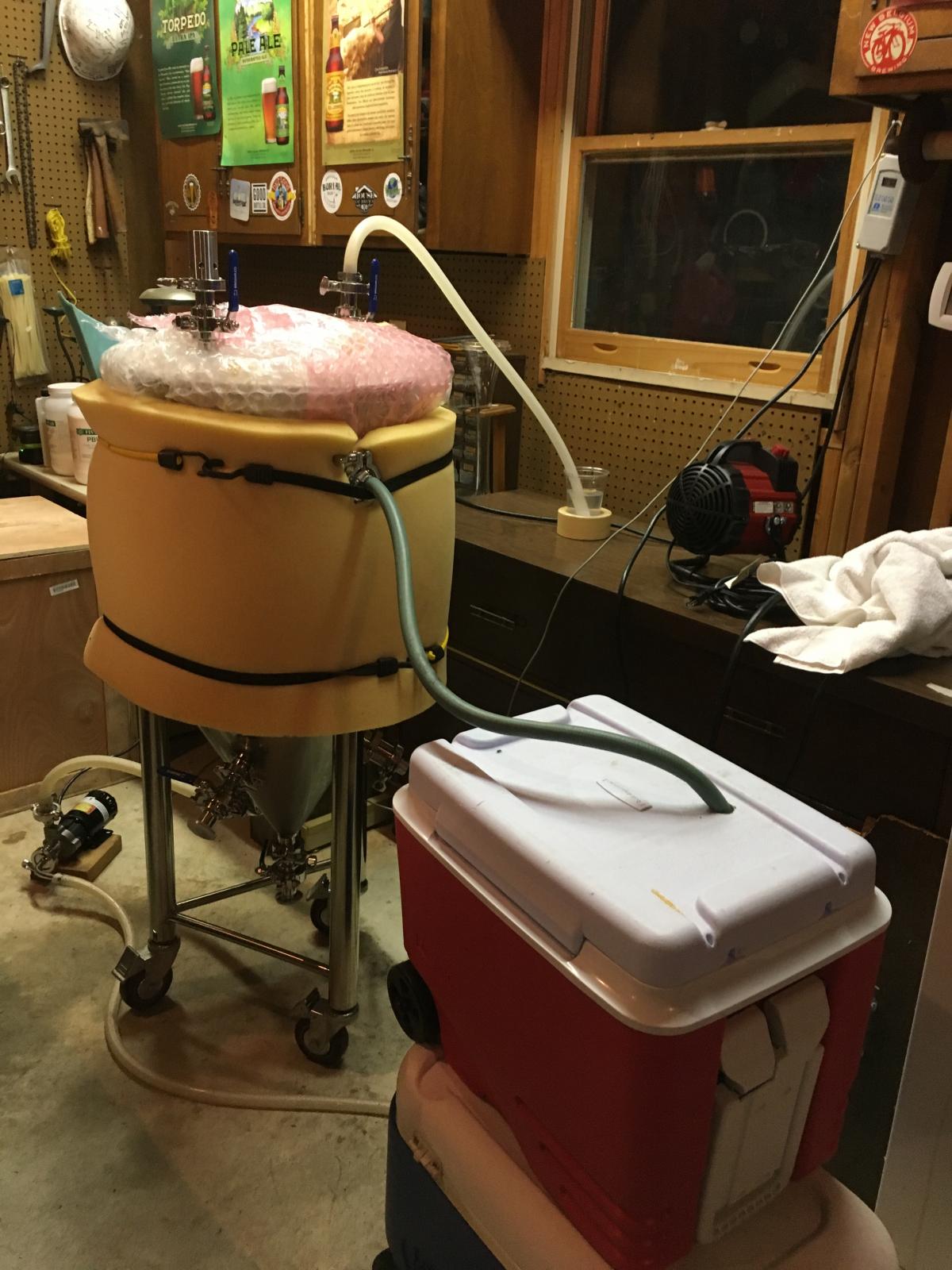
Thanks JB! I am giving more thought to adding Nathan's (BREWHA man) electronic power supply unit, but $500 + keeps me just thinking. I would like to have control of heating and cooling automatically. Right now I have to be present and change out from cold to warm water in the cooler. I have a couple aquarium heaters that sit on the cooler floor which I plug in when it is clear I need to add heat instead of hold down the fermentation temp via cooling.
It requires a lot of attention the first couple of weeks of fermentation. I have been brewing only Belgian beers: golden ale, saison and dubbel. And so if I added the dual temp controller from BREWHA and the electronic power controller I could use the heating element to add heat during fermentation. Nathan has advised to run the element at 2% heat input in order to avoid scorching the yeast.
I am on a photo on Nathan's website, pouring grain in the colander. And was "featured" on Nathan's website for having a problem with scorching during mash/boil. I pointed out to Nathan the issue, and another person sent a photo of his scorched element.
It's fun brewing with the BIAC. Although I have nothing to compare it to. Never used buckets, etc.
- Ron8
I built my own control panel which features a BCS-460 for temp control. It handles pretty much everything I need... mash, boil, chill, fermentation... even did a kettle sour via PID control that turned out awesome. Here's the link to the post with some details on how I've got it set up: https://www.homebrewtalk.com/showpost.php?p=7900245&postcount=991I did the bucket thing...20 years ago, then went to three vessels before dropping out of brewing for over a decade. The BIAC enticed me to return to brewing and haven't regretted it.
I have the ETC from Nathan and am considering an upgrade to a PID controlled system. I get too much variation (plus/minus 3F) in temperature (hysteresis) with the ETC. I do use the heating element through the power controller and have had no scorching at 3%. Seem to recall some gentlemen on this thread using a better temperature control system. Maybe one of them will chime in to advise. Were I to do it all over again, I wouldn't buy the ETC and seek another alternative to the power controller.
-jb
Hello, a general question for Brewha users;
How is the experience of brewing smaller batches than than the system is designed for? I'm thinking about starting with a 5BBL for a small brewery and brewing smaller batches for the beginning or off season / quiet times.
I guess the question is how small a batch have you been able to make comfortably in relation to the size of your system and what are the things to be aware of (I guess that taking care that the water level doesnt drop below the elements during sparge is a big one)
Thanks for any feedback about this..
Hello Hgearle,Nathan sells a great system that incorporates a power controller and a non-glycol chiller. I purchased the entire system and I have to say that it works great. If you decide to only purchase the partial system like Ron8 has decided to do, then it is almost impossible to replicate what Nathan had envisioned the way the system is supposed to operate. Lets face it, Nathans system is expensive and is not accessible to the the average home-brewer. I have ...almost...complete control over the temperature throughout the brewing process with as little as pushing a few buttons on my temperature controller. You will be amazed at how great the system is once you actually have the power controller and chiller to do all the work for you.
Hello Mdime,As you mention, keeping the level above the element is a major concern, but I would say that the limiting factor for batch size is the dead space under the mash colander. The large volume under the colander means that you start to run into mash thickness issues with small batches.
I've got the medium BIAC (1/2BBL) and find that 5.3-6 gallons (about 1/3 capacity) is about the smallest I can go when using the colander depending on the wort gravity I'm after. Compounding this is that at higher gravities the efficiency drops, requiring more grain and an even thicker mash. I'm not sure if that translates to the larger systems. You'd need to ask Nathan @ BREWHA for that info.
Hello Solstice Brewing,Sorry for the delayed response, but I see you already may have had this answered. I do have the unit that can be tuned to low percentages and although I haven't verified the accuracy of the power output at these low levels, it does the job for me. I'm able to keep the temps from getting too low with this with no overshoot. I also use this to ramp up my lagers for a dactyl rest (slowly going from 50F to mid-60's over a few days.
I was thinking of purchasing Nathan's dual temp controller and using it to power the analog controller and the pump for circulating cold water in the jacket.
Concerning digital control vs. analog power control on the unit shipped with my BIAC in Nov. 2014, I have been trying to learn if there is some way of just replacing the analog dial device with a digital controller. It is hard to find an answer to that. Do you, or any one else out there, know how that would be done, if it is even possible. I have seen a lot of videos and comments here about digital control, PIDs, solid state relays, pulse width modulation, and on. But haven't run across anything specific to my question. The BIAC power controller is too custom I guess for there to be much written about it.
- Ron8
If you have the dial type power controller, have you ever thought about attempting to use it at a very low input in order to add heat when needed during fermentation?
- Ron8
I was thinking of purchasing Nathan's dual temp controller and using it to power the analog controller and the pump for circulating cold water in the jacket.
- Ron8
Hello Solstice Brewing,
Thanks very much for your comments. If I could just ask for clarification, what reading do you set the dial controller at during fermentation, and in the case of when ramping up for diacetyl rest with lagers?
I almost missed reading this, and my apologies for not replying back sooner. Thanks very much for sharing that.
- Ron8

Yes, however I have the Electronic Temp Controller. I have set the power controller to 3% to hold the temperature just above the temperature in my basement (ie. 67F in the basement and I want to hold a fermentation temp of 70F). The Electronic Temperature Controller is a great piece of equipment.
The chiller is an expensive piece of equipment, but to me it is a necessity to hold fermentation temps with little thought or attention. I, too, use city water to cool all the way to pitching temps (cold water from Lake Michigan year round), then hook the BIAC to the chiller.
- Ron8
Looking at the picture you posted of your system, I see that you have 2 ball valves on the top of your lid. Why would you need any valves there? I have never seen the need, but would like to know if I'm missing something.
Also, I noticed that you are using a small cup for the blow off tube. The way my DIPA is bubbling away right now it would blow the water right out of that cup!
So it seems possible to replace the analog dial type power controller (potentiometer) with one that gives a % readout (digital?). I understand the pot will not control precisely enough to assure a 3% setting will really be 3%. True?
I have read on BREWHA site where it is VERY IMPORTANT to avoid going too high in power input (voltage input) during fermentation so yeast is not scorched.
Blowoff tube/cup. Works well, even during rapid fermentation, even with uncontrolled ferm temp, even above 75 F, poor technique, but I have done it, and it does not blow out the air lock. 50 starsan / 50 water.
Valves on lid. Valve on air lock so that when racking I can close it without having to remove the air lock. I use CO2 to push beer out the cone mounted racking port.
Valve on the other lid port is there to close while removing the pressure vacuum relief valve (PVRV), then attach a CO2 keg post for delivering CO2 to push beer out the racking port. Both ball valves are open during fermentation. The PVRV is a valuable safety feature to protect the medium BIAC from deformation in case of a major unplanned cooling event sucking in the inner wall of the vessel. Somebody on this thread had bad luck one time and sucked his vessel in. Expensive situation.

Hi Solstice Brewing,Howdy and no worries, my original reply was MONTHS later than your original question
For my medium system, I set my controller to 1% and that seems to do the job of holding the temps steady with no signs of scorching on the heating element post kegging. I might bump this up to 2% when ramping up, but that's not always necessary unless I want to have the temps rise quickly. I've got the entire fermenter within a 2" foam box to stabilize the air temps around it, so the heating element doesn't come on that often - even in the dead of winter (fermenter and box are in an unheated, but insulated garage).
As for wort chilling, I have a similar set up with hose water run through the jacket for part one of my chiller. In the winter, water temps are about 56F, so I just run it straight in. In the summer, water is more like 75-80F, so I run the hose to an immersion chiller in a 10 gal jug full of ice water. Part two of the chiller is to recirculate from the bottom of the conical back to the racking port with a 90 degree racking arm attached. This allows a number of things: a) it keeps the hot wort moving against the cool water jacket GREATLY reducing chilling time - very important. It also allows you to add gadgets between the pump and the racking port like a plate chiller. I've got a therminator inline with this system and run the same water from either the hose or the pre-chiller (via a wye connector) through the plates. Just cooled a Russian Imperial Stout this weekend from boiling to 66F in 14 minutes (granted, boiling at my elevation is about 198F). When I have a large hop load, I'll put a Hop Rocket in front of the plate chiller with either some rice hulls or some leaf hops to act as a filter to keep the break and veggies out of my therminator.
Hope this helps
Hi Solstice Brewing,
Yeah, I like your foam box idea. Any photos?
Circulating the wort during cooling is something I havent thought of. I dont circulate wort anytime. The first time I brewed with the BIAC I had major plugging in the pump during mash. So, I do not circulate ever. I know my efficiency would be better if I did, but just dont bother. Also avoids having to clean out the pump and tubing. I may change mind in the future. 14 minutes to cool wort surely is a great goal to shoot for. Is that for 10 gallons?
Maybe some time you could share photos of your immersion chiller and terminator in action.
Thanks for your comments and help.
Ron8
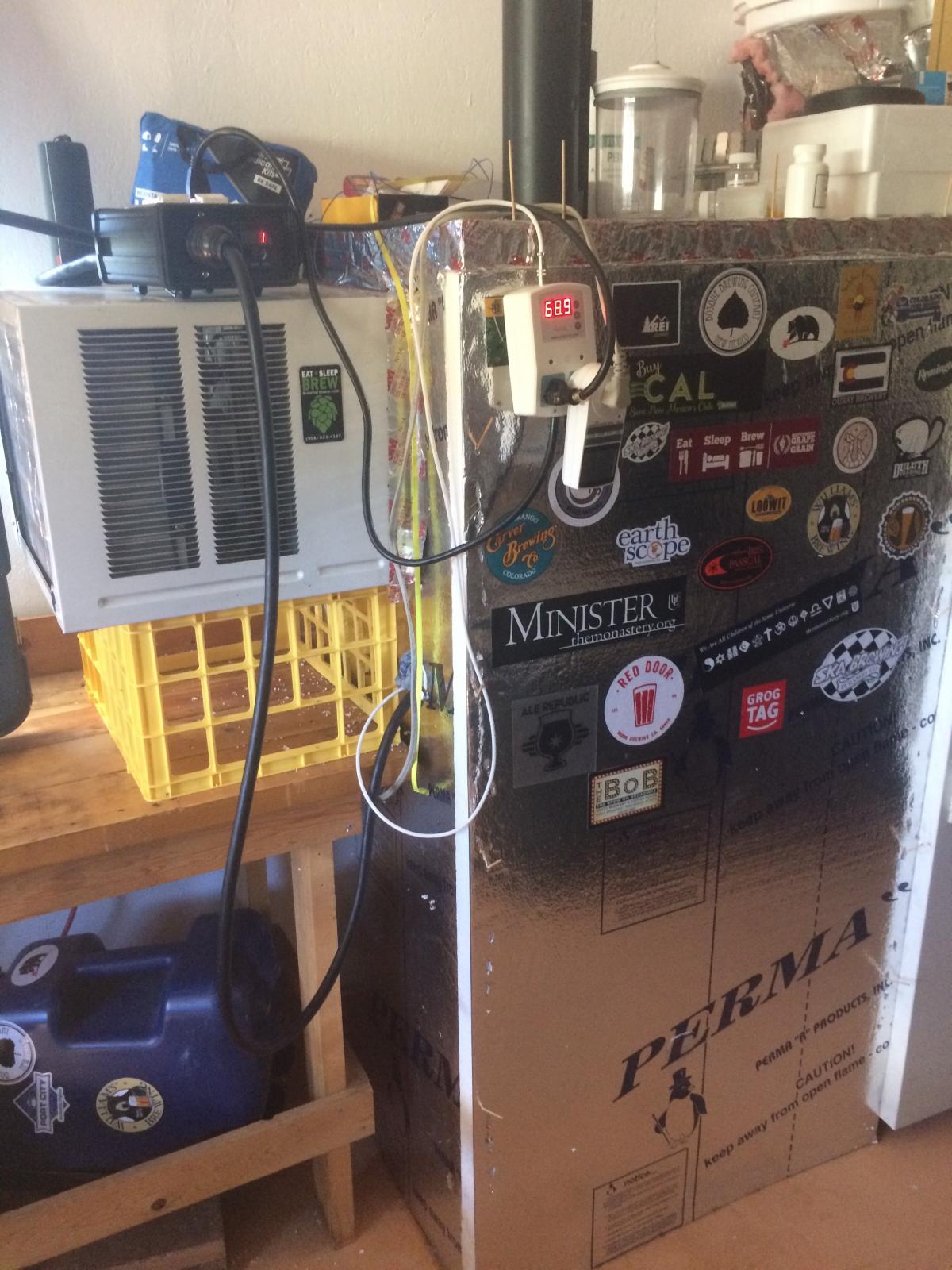
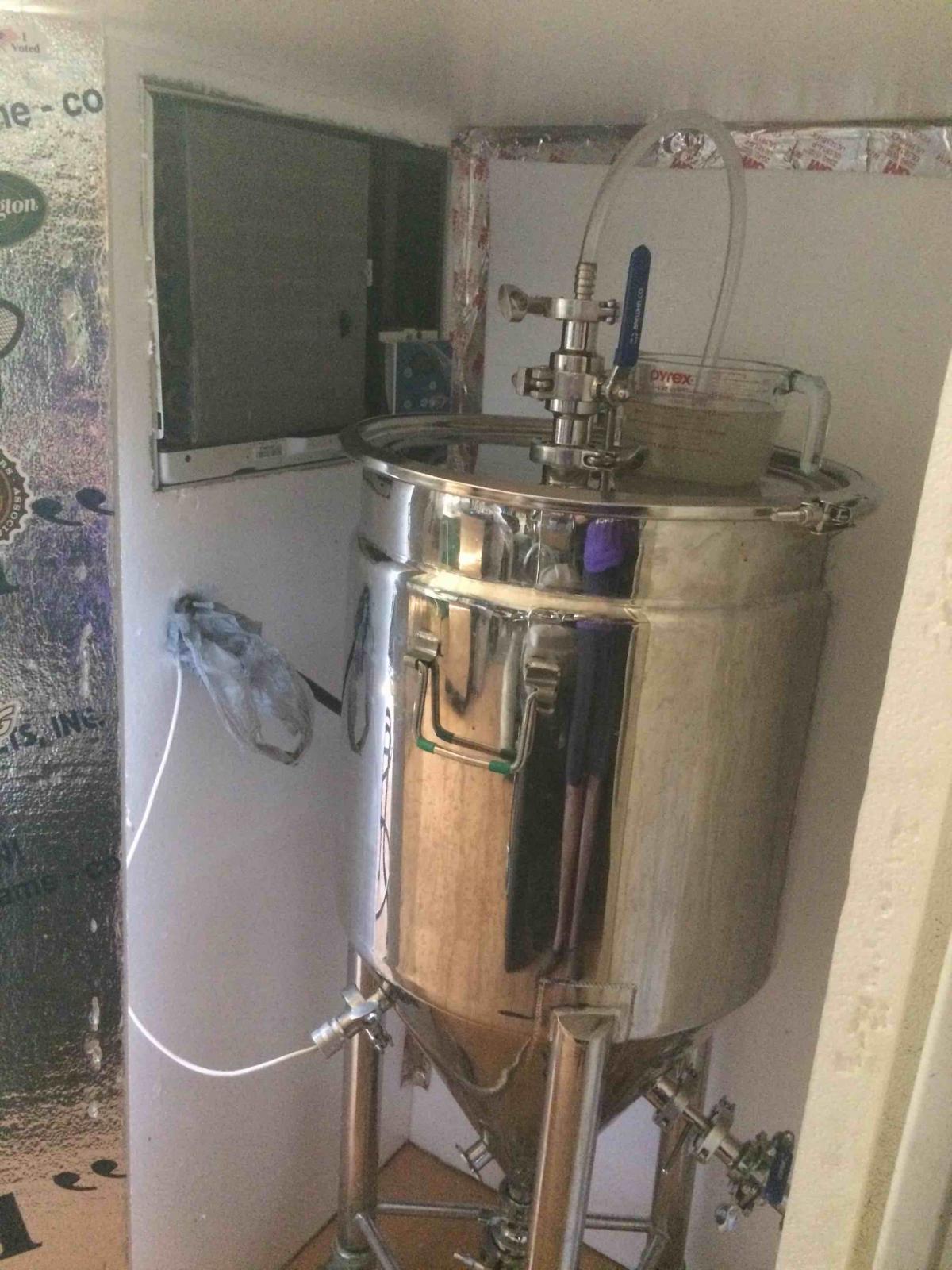
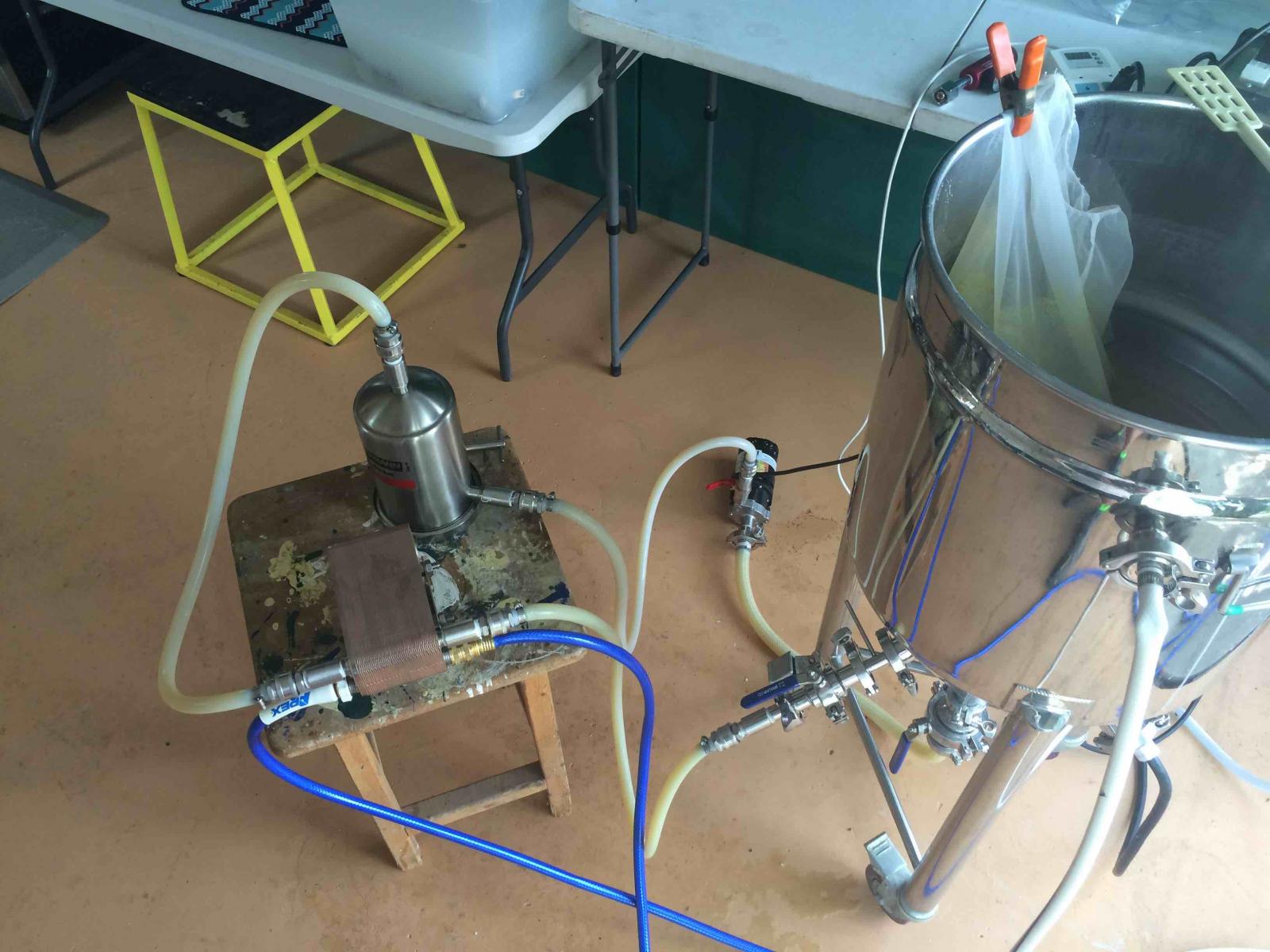
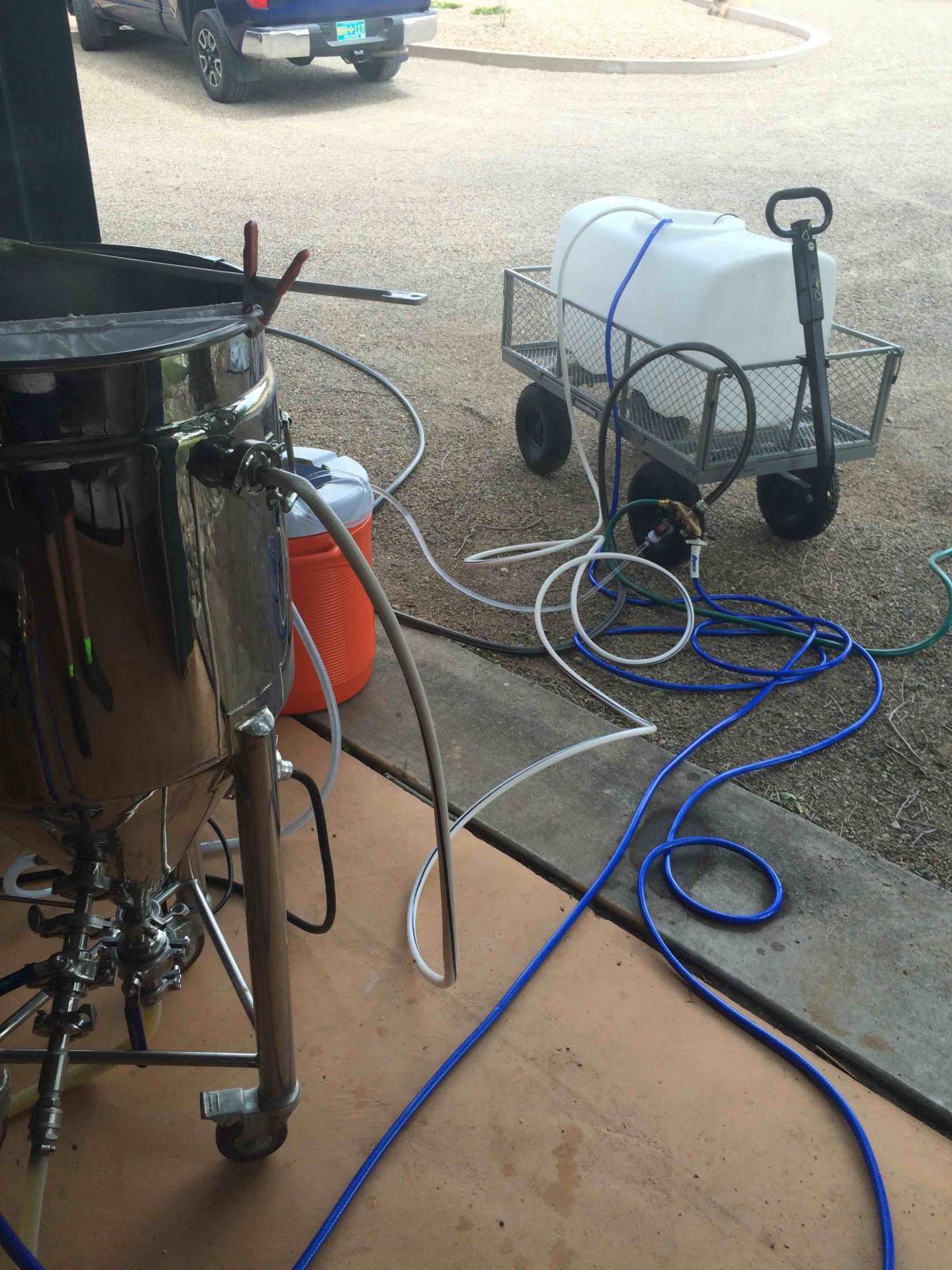
Circulating the wort during cooling is something I havent thought of. I dont circulate wort anytime. The first time I brewed with the BIAC I had major plugging in the pump during mash. So, I do not circulate ever.
Ron8
Hi Solstice,Forgot to respond to this. First time I used the system, I doughed in and THEN turned on the pump - clog city. Ever since, I have the water recirculating as I dough in and the grain that makes it through the colander on the first stages of the mash generally get caught up the next go around and the pump doesn't clog any more. I make sure it's running while I stir the mash as well - about every 15 minutes to equilibriate the temperature in the mash colander and move some of the liquid move through the wort - getting more uniform wort for intermediate SG and pH readings.
Then, of course, running the pump while chilling keeps hot wort in contact with the relatively cool jacket. Physics wins again!!
Enter your email address to join: